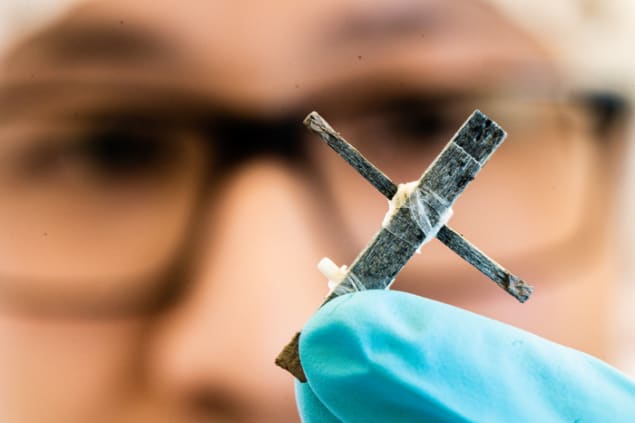
Researchers in Sweden have built a transistor out of a plank of wood by incorporating electrically conducting polymers throughout the material in a way that retains space for an ionically conductive electrolyte. The new technique makes it possible, in principle, to use wood as a template for numerous electronic components, though the Linköping University team acknowledge that wood-based devices cannot compete with traditional circuitry on speed or size.
Led by Isak Engquist of Linköping’s Laboratory for Organic Electronics, the researchers began by removing the lignin from a plank of balsa wood (chosen because it is grainless and evenly-structured) using a NaClO2 chemical and heat treatment. Since lignin typically constitutes 25% of wood, removing it creates considerable scope for incorporating new materials into the structure that remains.
The researchers then placed the delignified wood in a water-based dispersion of an electrically conducting polymer called poly(3,4-ethylenedioxythiophene)–polystyrene sulfonate, or PEDOT:PSS. Once this polymer diffuses into the wood, the previously insulating material becomes a conductor with an electrical conductivity of up to 69 siemens per metre – a phenomenon the researchers attribute to the formation of PEDOT:PSS microstructures inside the 3D wooden “scaffold”.
Next, Engquist and colleagues constructed a transistor using one piece of this treated balsa wood as a channel and additional pieces on either side to form a double transistor gate. They also soaked the interface between the gates and channel in an ion-conducting gel. In this arrangement, known as an organic electrochemical transistor (OECT), applying a voltage to the gate(s) triggers an electrochemical reaction in the channel that makes the PEDOT molecules non-conducting, and therefore switches the transistor off.
Transistor performance
Writing in PNAS, the researchers report that the new wooden transistor modulates electrical current in a 1-mm-thick transistor channel with an on/off ratio of 50. Compared to typical modern transistors, it operates with a considerable delay: switching the power on takes about five seconds, while switching off takes one second.
“Our wood transistor operates according to a different principle to conventional silicon transistors that switch using an electric field,” Engquist explains. “Compared to these transistors, it is really slow and bulky and we don’t expect it to ever compete with traditional microprocessors and circuits.”
The new device does respond well to gate voltage modulation, performing on a par with other OECTs in this respect. However, the researchers stress that they didn’t develop the wood transistor with any specific applications in mind. “We did it because we could,” Engquist says.
Things to do with a wooden transistor
When pressed, Engquist suggests that possible applications could include regulating electronic plants and any devices in which, for some reason, electrical functionality is needed inside wood.

Fungus turns wood piezoelectric, allowing it to power LEDs
“Since the channel of our transistor is so big, it could possibly tolerate higher currents than regular organic transistors,” he tells Physics World. “We could imagine, for example, regulating the current to/from future sensors, solar cells, displays or batteries incorporated into wood.”
The researchers are now exploring ways to improve the electric properties of their conductive wood. “We also hope to be able to create new devices together with our colleagues at the Laboratory of Organic Electronics, who are among the pioneers in the area of electronic plants.”



